Childhood should be a time for curiosity, play, and growth. But for millions of kids today, anxiety overshadows these years. It's vital to understand anxiety in children. Many families now see that ongoing worry and fear aren't just phases kids outgrow.
Understanding Childhood Anxiety
Defining anxiety in children means spotting when everyday worries become serious. It's more than just being nervous before a test or shy at school. Anxiety is a steady worry or fear. It can cause physical symptoms that affect daily life at home, school, and with friends.
Childhood anxiety can appear in many ways. Kids might worry about things going wrong, miss their parents, feel anxious in social situations, or fear particular objects. These feelings can be very strong. They can disrupt normal activities and prevent kids from enjoying life.
Why This Matters
Childhood anxiety is important to address because it doesn't go away on its own as kids grow older.
Research shows that children with anxiety disorders often face anxiety as adults. They are also more likely to feel depressed. They may struggle academically and in social situations. Early recognition and treatment can greatly improve these outcomes.
Anxiety in kids is a big worry for parents, teachers, and doctors. About one in eight children has anxiety disorders, and this number is rising.
Factors driving this rise are:
- Increased academic pressure
- Social media use
- Family stress
- Societal changes affecting children's safety and security
Understanding Anxiety in Kids
Understanding everyday worries and clinical anxiety helps parents support their children's emotional needs more effectively.
Normal Worries vs Clinical Anxiety
Normal worries and clinical anxiety differ in three main ways:
- Intensity
- Duration
- Impact on daily life
All children face occasional fears and worries that are normal for their age. For instance, toddlers often have separation anxiety. Older kids might worry about school or friendships.
Clinical anxiety, however, involves excessive and lasting worries. These worries can greatly disrupt daily activities. If anxiety keeps a child from school, fun activities, or friends, it's more than normal worry. It's a disorder that needs help.
Common Triggers and Stressors
Common triggers for children include:
- School-related pressures: Tests, presentations, or academic expectations.
- Family situations: Parental conflict, divorce, or financial stress.
- Social pressures: Peer relationships, bullying, or social media comparison.
Sports anxiety can happen when kids feel pressured to compete. They may also worry about disappointing their coaches and parents.
Anxiety in kids often comes from many factors, not one. Understanding these triggers helps families address anxiety more effectively.
Impact Across Multiple Domains
Anxiety impacts a child's emotions, behavior, and physical health. This creates challenges in many areas of their life.
Anxious children often feel a heightened sense of tension. They may have mood swings or intense fear reactions. Anxiety can lead to avoidance of situations that induce worry. It can be hard to separate from parents. This may lead to angry outbursts when dealing with fears.
Physical symptoms are also common in childhood anxiety. Kids may experience headaches, stomach aches, muscle tension, fatigue, and sleep issues. These symptoms are real, not just in your head. They come from your body's stress response, such as working too hard.
Signs and Symptoms of Anxiety in Kids
To spot anxiety symptoms in kids, you must understand how it appears in their emotions, behavior, and physical signs.
Emotional Warning Signs
Emotional signs of anxiety in kids include ongoing fear or worry. This fear often feels too intense for what's happening. They might worry a lot about the future. This can make it difficult for them to manage their emotions, which may result in crying or irritability. Kids might voice fears like, "What if something bad happens?" or "I am scared something will go wrong."
Anxiety and anger often go hand in hand. Kids might show anxiety through irritability, frustration, or anger when they feel overwhelmed. This link usually surprises parents, who expect anxiety to show as fear instead of anger.
Behavioral Indicators
Behavioral signs of anxiety in kids include:
- Avoid situations that trigger worry, such as school, social events, or new activities.
- Clinging to parents or caregivers and having trouble separating from them.
- Refusing to take part in normal childhood activities.
- Developing rituals or compulsive behaviors to cope with anxiety.
- Experiencing tantrums or meltdowns that feel too intense for the situation.
Sleep anxiety in kids often shows up as:
- Trouble falling asleep.
- Nightmares.
- Needing parents nearby to fall asleep.
These sleep disruptions can worsen anxiety symptoms during the day, creating difficult cycles.
Physical Manifestations
Physical symptoms are common in anxious children. These include common stomachaches without a medical cause, headaches, muscle tension, fatigue, and low energy, even when one is well-rested. Kids might also have changes in appetite. They may feel anxious about eating or fear trying new foods. Other symptoms are a fast heartbeat, trouble breathing during anxiety, and frequent bathroom visits, especially when stressed.
Anxiety and stomach issues in kids are linked. The gut-brain connection makes the digestive system very sensitive to emotional stress.
When Professional Help Is Needed
Seek professional help when anxiety lasts for weeks or months. If it disrupts school, friendships, or family life, it's time to act. Unexplained distress or physical symptoms show a need for support. If you have panic attacks, thoughts of self-harm, or avoid things a lot, see a professional right away.
Types of Anxiety Disorders in Children
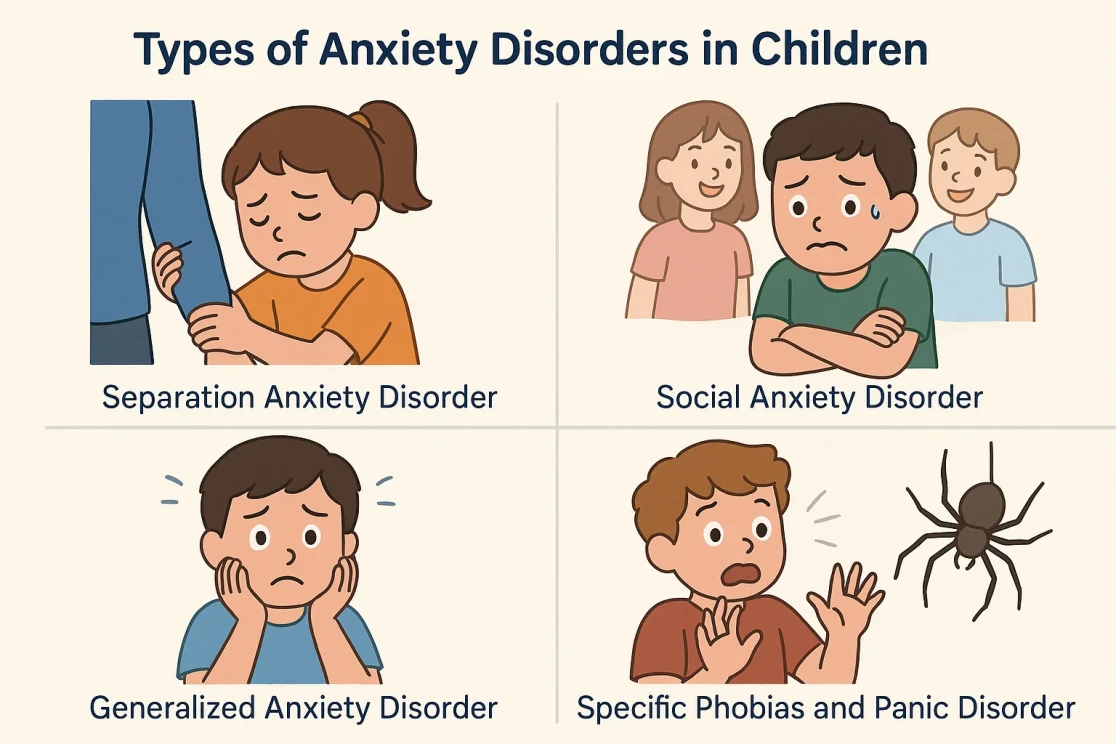
Understanding specific anxiety disorders helps families recognize patterns and seek appropriate treatment.
Separation Anxiety Disorder
Separation anxiety disorder is a deep fear of being away from parents or caregivers. Kids aged 5 to 7 often feel anxiety. But it turns into a disorder when the fear is strong, causes distress, and disrupts daily life.
Children with this disorder might not want to go to school. They may panic when their parents leave or worry a lot about their parents' safety. They might also exhibit physical symptoms when they expect separation. This condition needs understanding and proper treatment. It's not enough to keep kids apart.
Social Anxiety Disorder
Social anxiety in kids means they feel intense fear in social situations. They worry that others will judge, embarrass, or watch them. This is more than just shyness. It includes a fear of attending parties, eating with others, speaking in class, or participating in group activities.
Children with social anxiety often skip social events. They find it hard to make friends. They might feel symptoms like blushing, trembling, or nausea when near others. Without treatment, social anxiety can significantly limit children's social development and future opportunities.
Generalized Anxiety Disorder
Generalized anxiety disorder (GAD) means worrying too much about various issues. These include school performance, family matters, friendships, health, future events, and global happenings. Children with GAD always expect bad things to happen. They can't stop worrying, even though they know it's too much.
Constant worry drains kids emotionally and physically. This can cause trouble focusing, feeling irritable, muscle tightness, and issues with sleep.
Specific Phobias and Panic Disorder
Phobias and specific fears are strong, irrational fears of certain things. These can include dogs, insects, heights, needles, or thunderstorms. These fears go beyond normal caution to cause panic and significant life disruption.
Panic disorder and panic attacks can happen in children, but it's less common than in adults. Anxiety attacks in kids are sudden and intense. They can create fear and physical symptoms. These include a fast heartbeat, sweating, trembling, and trouble breathing. Kids may also feel like they are losing control or dying.
Causes and Risk Factors
Understanding what causes anxiety in kids helps families. It shows that anxiety usually comes from many factors, not just one.
Biological and Genetic Factors
Biological factors involve differences in brain chemistry. This is especially true for neurotransmitters that control mood and anxiety. Genetics matter a lot. Kids are at a higher risk for anxiety if their parents or siblings have anxiety disorders. Temperament is important too. Children with sensitive or cautious temperaments tend to develop anxiety more easily.
Environmental Influences
Environmental factors include:
- Stressful family situations
- Exposure to trauma or violence
- Overprotective or critical parenting
- Academic pressure and school stress
- Bullying or social challenges
- Major life changes, like moving, divorce, or family illness
Learned Behaviors
Children can learn to be anxious in several ways:
- They may watch anxious family members.
- They receive messages that the world is unsafe.
- They get rewarded for avoiding situations.
- They miss chances to build confidence in tackling challenges.
Knowing these causes helps families tackle risk factors. They can also find the right treatment for anxiety symptoms.
Impact of Anxiety on Child Development
Childhood anxiety affects growth in many ways. If left untreated, it can have lasting effects.
Academic Impact
Anxiety impacts school performance in several ways. It can make it hard to concentrate. Students might avoid school or certain classes. Perfectionism may stop them from finishing tasks. Physical symptoms can lead to missed school days. Anxious children often underperform relative to their actual abilities.
Social Development
Social development can struggle when anxiety stops children from making friends. It also affects their participation in group activities. Without practice, they miss opportunities to develop social skills and build confidence in social settings. This isolation can worsen anxiety and depression in kids over time.
Emotional and Physical Health
Long-term anxiety harms emotional growth. It stops kids from learning to manage their feelings. They struggle to build resilience, solve problems, and keep a positive self-image. Physical health impacts include chronic stress, which affects immune function. It can also disrupt sleep and lead to issues like stomach problems and headaches.
Coping Strategies and Treatment Options
Treating childhood anxiety usually requires a mix of methods. These should fit the child's unique needs and situation.
At-Home Strategies
Parents can use different strategies at home to help reduce anxiety in kids.
Teaching kids coping skills for anxiety involves:
- Deep breathing exercises
- Progressive muscle relaxation
- Positive self-talk
- Grounding techniques
Creating predictable routines reduces the uncertainty that fuels anxiety.
Coping strategies for kids with anxiety include:
- Gradual exposure to feared situations with support.
- Developing problem-solving skills.
- Validating their feelings while encouraging brave behavior.
Anxiety activities for kids in therapy often translate into home practice activities.
Some families consider magnesium supplements for kids with anxiety. They do this only with medical guidance. Research on how well they work is limited. Supplements should not replace proven treatments.
Professional Treatment Options
Cognitive Behavioral Therapy (CBT) represents the gold standard for treating childhood anxiety. CBT helps kids spot anxious thoughts. They learn to assess the accuracy of these thoughts. Then, they can build more realistic thinking patterns. Finally, they face the situations they fear one step at a time. CBT helps reduce anxiety symptoms in children, according to research.
Counseling and play therapy offer good options for younger kids. They can help those who find traditional talk therapy hard. Play therapy helps kids share their fears. They can use play to deal with anxiety.
In severe cases, doctors may prescribe medication if anxiety greatly affects daily life and other treatments haven't helped enough. Medication is typically used alongside therapy rather than as a standalone treatment.
School-Based Support
Teachers and counselors play a key role in supporting students. They recognize anxiety symptoms and make accommodations to reduce triggers. They create safe spaces for stressed children. They also discuss concerns with families.
Creating a supportive learning environment means lowering performance pressure. It's essential to teach all students about mental health. Addressing bullying effectively is key, too. Additionally, children should feel secure in asking for help when they need it.
How Parents and Caregivers Can Help
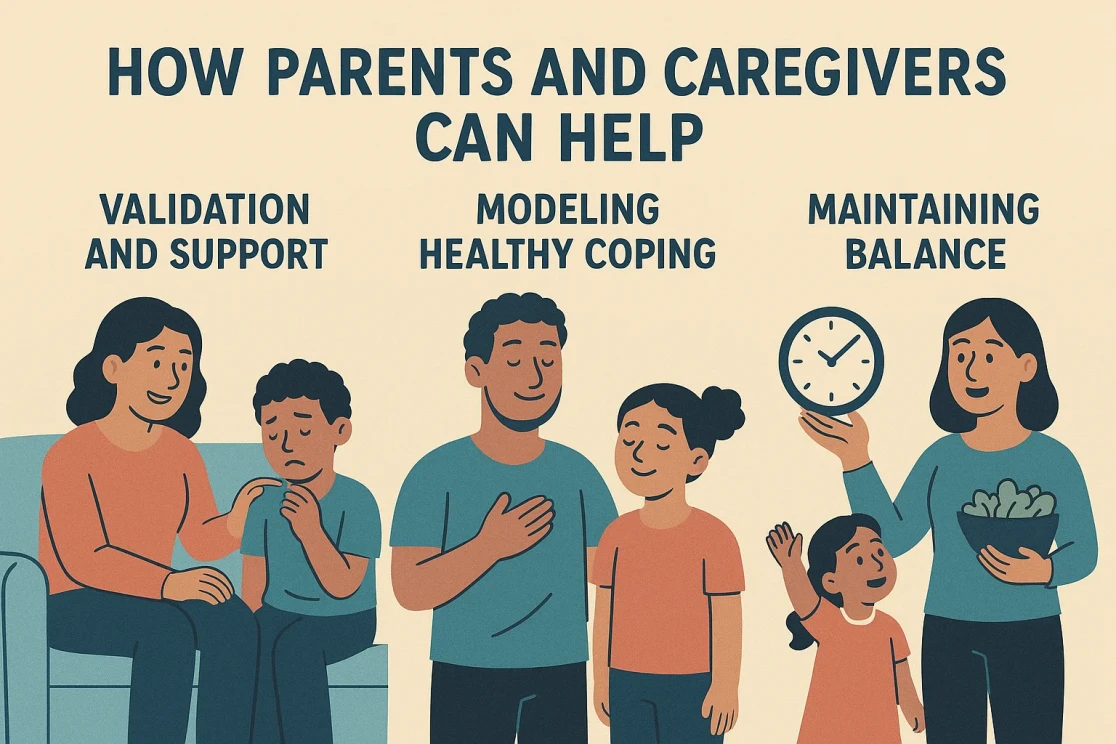
Parents help kids manage anxiety by providing daily support and long-term strategies.
Validation and Support
Validating children's feelings means recognizing their fears as real. It also means encouraging them to be brave instead of avoiding those feelings. Don't brush off anxiety with comments like "there's nothing to worry about." Also, avoid overprotecting, as this can imply that situations are inherently dangerous.
Modeling Healthy Coping
Children learn by watching parents handle stress and anxiety. To show kids healthy ways to cope with anxiety, share how you handle your own worries. Talk about feelings openly—also, model problem-solving instead of avoiding issues.
Maintaining Balance
Parents should not let anxiety take over family life. They also need to recognize when real distress needs support. This balance means helping kids face their fears with support and encouragement. We shouldn't push them into scary situations or let them avoid them completely.
Prevention and Early Intervention
Early identification and intervention lead to better outcomes for children with anxiety.
Recognizing Early Signs
Identifying early warning signs involves:
- Noticing when worries are too much for the child's age.
- Watching for patterns of avoidance.
- Recognizing physical symptoms in stressful situations.
- Observing changes in social life or school performance.
Anxiety checklists for kids can help parents decide if they should see a professional.
Building Resilience
Teaching resilience and coping skills helps all kids, not just those with anxiety.
Output: This involves helping children solve problems independently. It also means introducing them to small challenges. Teaching emotional regulation skills is key. Lastly, we build their confidence by letting them succeed.
Creating Supportive Environments
Creating a positive and safe home means:
- Keeping routines predictable.
- Encouraging open talks about feelings.
- Setting clear limits while staying warm and supportive.
- Managing stress that can affect children.
- Reducing exposure to news or media that may raise anxiety.
Conclusion
Anxiety in kids is a serious issue. It needs recognition, understanding, and proper help. Childhood anxiety is a common mental health issue. It affects millions of kids and their families.
Knowing that childhood anxiety is treatable gives hope to families. With the right help, therapy, and sometimes medicine, most kids with anxiety can manage their symptoms well. They can grow into confident and capable adults.
The key is to recognize anxiety symptoms early. Seek help when needed and use effective treatments. Parents, schools, and healthcare providers play a crucial role in supporting anxious kids to lead healthier lives.
At Gendrics, we understand that tackling childhood anxiety requires a comprehensive approach. Anxiety can appear as fears of separation, social worries, or general unease. Help is out there. Responding to childhood anxiety with care can change a child's future for the better.

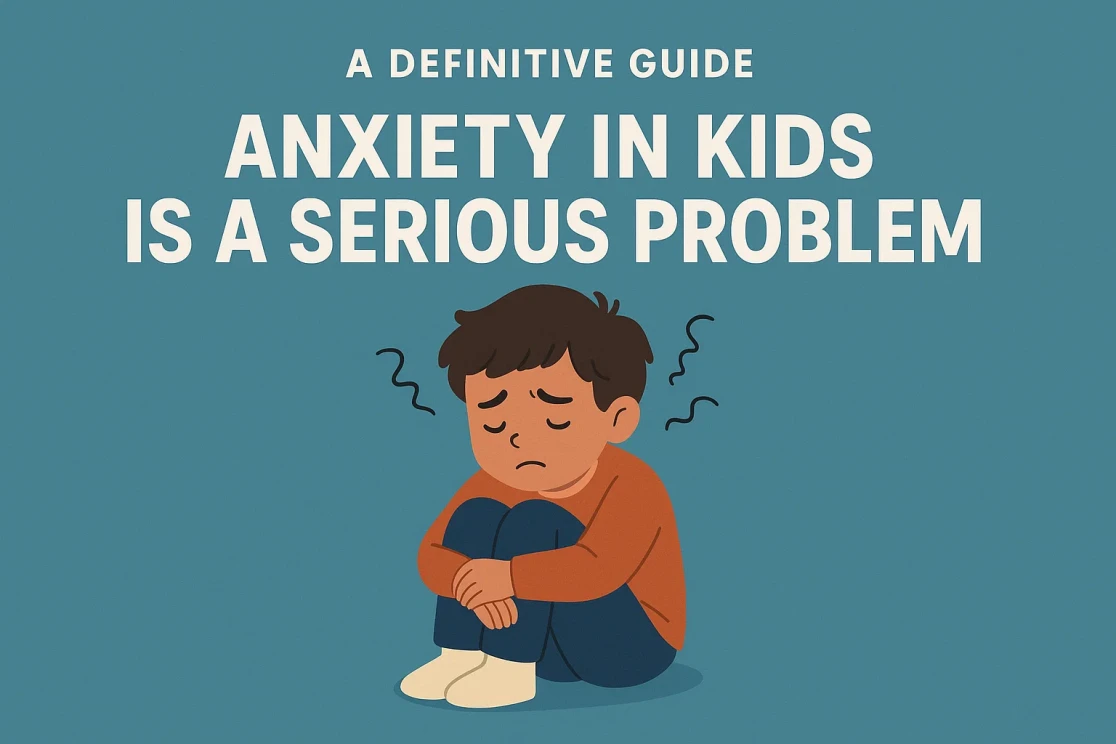
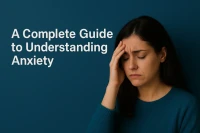
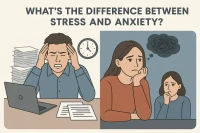
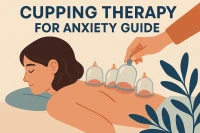
Comments